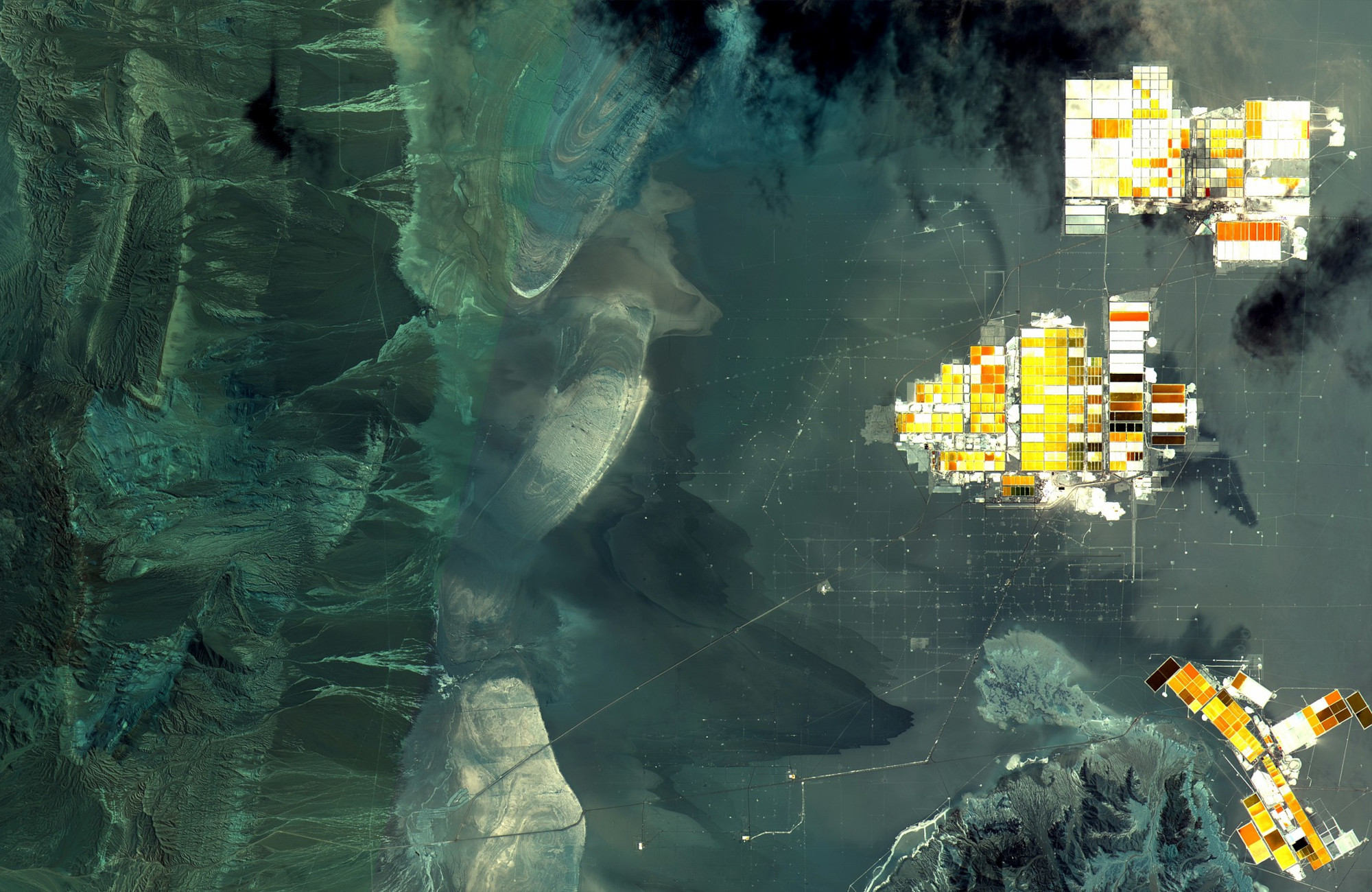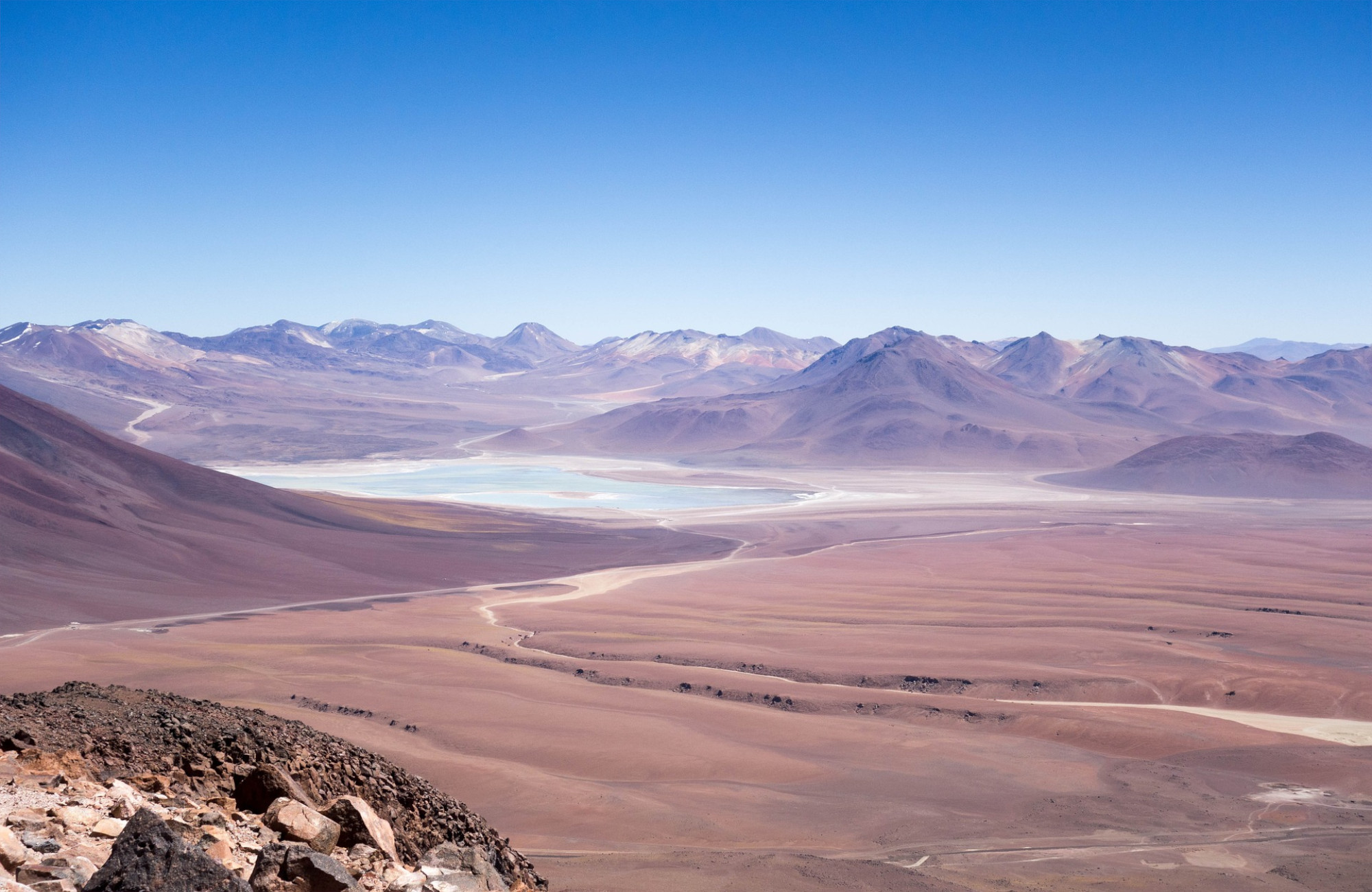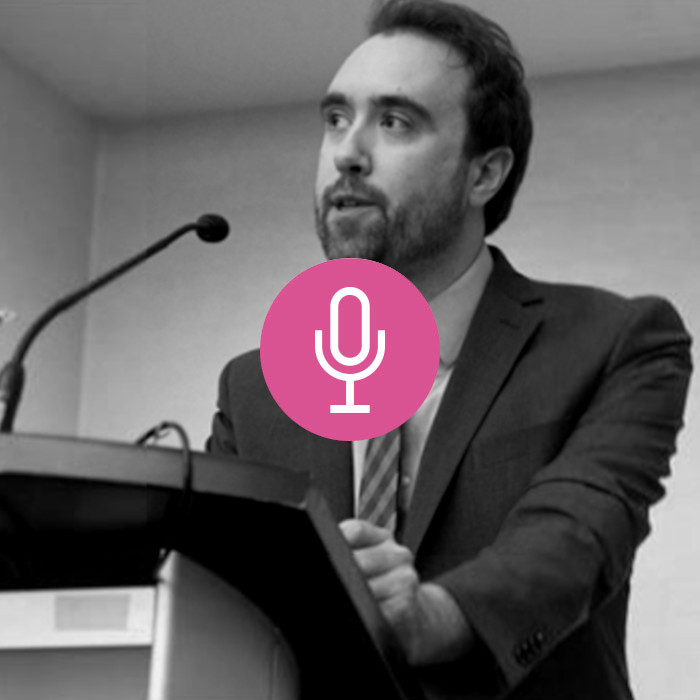Surrounded by the Atacama Desert, the driest place in the world, at 2,300 meters above sea level, the Salar de Atacama is a natural wonder of the world. Its 100-km-long shore of rocky white salt formations contrasts with electrifying turquoise waters where pink flamingoes graze on the algae and plankton growing in the brine.
This Andean ‘dead sea’ is both full of life and a source of life. Its hydrological system not only sustains a unique and fragile ecosystem of endangered flora and fauna, but also provides enough water for the Atacameño and Quechua Indigenous peasant communities who have traditionally lived off the land. This exotic natural salty marvel, allowing for life in one of the toughest places on earth, also contains lithium, a metal that has been hailed as the key to stopping carbon emissions and escaping our trajectory towards ecocide.
Following this death drive, while at the same time trying to escape extinction, the Salar de Atacama, as well as dozens of other smaller salt flats, are being sacrificed to extract a non-renewable resource that is at the centre of a ‘green’ revolution in which renewable energy will be storable, abundant, and cheap.
Global demand for lithium has doubled in the last decade. As the lightest metal on the planet, and with the capacity to support high energy density, lithium is mostly used to manufacture lithium-ion batteries to power small portable electrical devices such as mobile phones and laptops, as well as electric vehicles, which are set to account for up to 60% of new car sales by 2030. While the current global demand for lithium comes mainly from the Global North economies, lithium deposits are mainly in the Global South, evidencing the “colonial shadow of green electromobility.”
Sixty percent of the world’s lithium is in Latin America and it is concentrated in salt flats near the borders of Chile, Argentina, and Bolivia, in an area known as the Lithium Triangle. The Salar de Atacama not only stores a quarter of these lithium reserves, but its brine has the highest concentration of lithium while its location at a lower altitude allows for a quicker process of solar evaporation and thus lower production costs.
Brines, which are the main raw material for producing lithium, are put into evaporation pools to extract the metal. This process implies pumping out more than two million litres of water per day from the salt flats; approximately 2.2 million litres of water are needed to produce one ton of lithium. This immense loss of water creates pressure on water cycles and negatively affects the regeneration of the fragile high Andean wetlands. The Atacama salt flat is a complex aquifer system, receiving water from the San Pedro and Vilama rivers, as well as from underground streams. The small town of San Pedro de Atacama, 55 km north of the Salar, historically an agricultural oasis growing alfalfa, corn, and pears, has been recently experiencing shortages of water. Climate change as well as decades of copper and lithium mining has now created a hydric crisis in the area, with the San Pedro River losing a third of its flow since 1984, and with both rivers declared water depleted in 2016 and 2017.
Even if the extraction of water from the Salar de Atacama far exceeds its capacity for regeneration, the state, as a way to respond to the higher global demand for lithium and to cash in on it, recently increased the quotas for extraction of brine from the basin. The centre-Left government of Gabriel Boric also unveiled a National Lithium Strategy that seeks to increase production and exploit the metal through public-private ventures and the use of direct lithium extraction. Until now, the lithium business has been exclusively in the hands of two companies: Albemarle, an American transnational corporation based in North Carolina, and the Chilean SQM.
The interest in lithium commenced half a century ago, when the metal was first discovered in the Salar de Atacama. During the Pinochet dictatorship, lithium was declared of “nuclear interest,” a strategic resource that was of exclusive property of the state, and therefore “non-concessional,” which means that the right to its perpetual exploitation could not be given away, as was the case with copper. The special character of lithium was then written into law in Articles 7 and 8 of the 1983 Mining Code, which excluded it from the new neoliberal mining rights, and allowed the state to either directly engage in mining through its companies, or to outsource the exploration and extraction via “administrative concessions” or “special operating contracts.”
The exploitation of lithium began in the southern sector of the Salar de Atacama through the Chilean Society of Lithium (SCL), a private-public joint venture in which the US Corporation Foote Mineral Company, which had experience mining lithium in Clayton Valley, Silver Peak, Nevada, controlled 55%. In 1989, right before democracy was restored, SCL was fully privatized and today its owner is Albemarle, which also controls the largest lithium mines in Australia.
Given the negative impact of lithium extraction for the Indigenous communities in Atacama and Chile’s ratification in 2008 of ILO Convention 169 granting Indigenous peoples a right to previous consultation for development of projects on their territories, Albemarle set up negotiations with the Indigenous communities to avoid conflicts and obtain authorisation to expand its extraction. In 2016, after signing an agreement with the local communities, in which the company agreed to transfer 3% of its sales to fund community projects, Albemarle was granted a new contract until 2043, which duplicates its lithium extraction quotas.
The history of lithium extraction of the national company SQM has been considerably dirtier than Albemarle’s cash transfers in exchange for accelerating the degradation of a fragile ecosystem. In 1986 the State had established another private-public joint venture, Mining Society Salar de Atacama (Minsal), which was then fully privatised and acquired in 1993 by SQM —which had been itself a public company until it was bought by Julio Ponce Lerou, Pinochet’s son-in-law.
SQM began extracting lithium from the Salar de Atacama in 1996, and in 2005 it opened a lithium carbonate plant close to the city-port of Antofagasta. In 2007, tempers flared when SQM dumped wastewater near the Peine Indigenous community. Then, in 2015, the company was involved in a big corruption scheme to illegally fund politicians across the ideological spectrum. According to investigations that were later shut down, SQM gave 14 million dollars between 2009 and 2014 to public officials, from the Minister of Interior of then Socialist President Michelle Bachelet, to far-right senators. Two years later, protests at its lithium extraction sites reemerged, prompted by the renewal of the company’s contracts. The courts sided with the company and the state granted the contract in 2018, almost duplicating SQM’s extraction quotas until 2030.
The recent announcement of the Chilean government for a National Lithium Strategy does not seek to nationalise lithium as such — lithium is already of exclusive property of the state — but to launch a new wave of joint ventures in which the state will be the largest shareholder. For lithium extraction, this new strategy means, on the one hand, that when the special operating contracts of SQM and Albemarle are up for renewal in 2030 and 2043 respectively, the companies will have to sell 55% of their shares to the Chilean State, and on the other, that new explorations and exploitations will be done through joint public-private ventures. The government’s proposal is that Codelco, the public copper company, takes over the lithium business. Even if state participation in the extraction of lithium will increase public revenue, in terms of the preservation of fragile ecosystems and relations with Indigenous communities, this is hardly auspicious news. Chuquicamata, the Codelco-run copper mine, is the largest polluter in the area, with a dismal environmental protection track record.
Dr Camila Vergara is a Marie Skłodowska-Curie Fellow at University of Cambridge working on a longue durée analysis of the rights of the common people from antiquity to the present. Find her on Twitter @Camila_Vergara
Further reading:

- Opinion
- By Meabh Byrne
- 20 February, 2023





